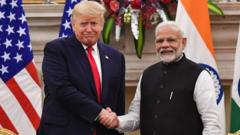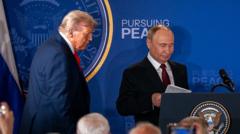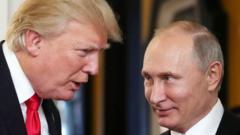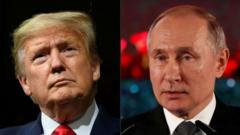As the July 9 deadline approaches, negotiations between India and the US for a significant trade deal encounter hurdles primarily regarding agricultural access, tariffs, and non-tariff barriers. With both parties seeking to protect their interests, the outlook for a conclusive agreement remains uncertain.
India-US Trade Negotiations: Bumps on the Road to a Possible Deal

India-US Trade Negotiations: Bumps on the Road to a Possible Deal
The anticipated India-US trade agreement faces challenges as negotiators grapple with key issues ahead of the looming deadline.
Is the "big, beautiful" trade deal between India and the US facing critical obstacles? With a July 9 deadline rapidly approaching, expectations for an interim agreement remain alive. However, negotiations appear increasingly complicated due to persistent differences.
Hints from White House Press Secretary Karoline Leavitt indicated that a deal was nearing, while Indian Finance Minister Nirmala Sitharaman confidently referenced a "big, good, beautiful" agreement in response to President Donald Trump’s earlier optimism. Yet, discussions are mired in tough bargaining, particularly concerning agricultural access, auto components, and Indian steel tariffs.
Indian trade officials have chosen to extend their stay in Washington to engage in fresh negotiations, albeit with Delhi asserting "very big red lines" regarding farm and dairy protections. US negotiators are pursuing broader market access, heightening the urgency to reach a compromise. Ajay Srivastava, a former Indian trade official, emphasized that the upcoming week could determine whether the two nations agree on a limited "mini-deal" or abandon talks altogether, at least temporarily.
Richard Rossow from the Center for Strategic and International Studies highlighted key challenges: Firstly, the contentious issue of US access to India's agricultural market, where India seeks to protect its farmers for economic and political reasons. Secondly, the US continues to raise concerns about India's non-tariff barriers, such as the growing set of Quality Control Orders (QCO) that inhibit market access.
While current farm trade between India and the US remains modest, valued at approximately $8 billion, there is pressure from the US to increase agricultural exports. The potential for tariff concessions might force India to reconsider its protections on minimum support prices, impacting over 700 million rural residents.
Interestingly, a recent Niti Aayog paper proposed tariff cuts on various US farm imports, signaling a complex landscape of interests and governmental policies. It remains unclear whether this proposal embodies official government policy or represents mere suggestions.
Experts foresee a higher likelihood of a limited trade agreement focused on tariff reductions and strategic commitments. The proposed "mini-deal" could involve tariff cuts on industrial goods, limited agricultural access, and larger commercial procurements in sectors such as oil, aircraft, and multi-brand retail.
The initial trade talks were built upon mutual benefits—manufactured goods from the US focused on capital-intensive sectors, while India aimed at labor-intensive items. However, developments reflect a shift away from this collaborative framework. If negotiations falter, experts conclude that Trump is unlikely to impose back the 26% tariffs on India, although surprises could still occur, given the unpredictable nature of US politics under his administration.






















